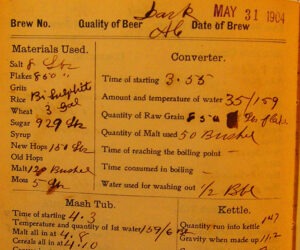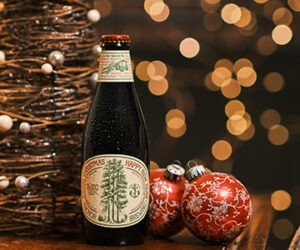Colonial Ale
Have you ever dreamed about digging in the ground and having your shovel strike treasure? A chest of gold coins, perhaps? Or maybe, even better, a well-preserved bottle of beer? I may not have unearthed a bottle, but I found the next best thing while studying a colonial plantation in Virginia.
I am an archaeologist with a primary research interest in the 17th- and 18th-century plantation cultures of the New World colonies. As a homebrewer and home winemaker, I’m also fascinated by the role these beverages played in historical societies. I’ve found a wealth of relevant information at the 15-year archaelogical study of Curles Plantation on the James River in eastern Henrico County, Virginia.
From 1699 to about 1840, Curles was owned by four generations of the Randolph family. Three generations of Randolph women, all named Jane, left behind a type of cookbook called a “receipt” manuscript. Inside, I found a recipe for “Good Ale” from Mrs. Cary, a relative who lived across the river. Here is her original recipe.
Mrs. Cary’s Good Ale
“Take 3 Bushels malt 1/2 high & 1/2 Pail dry’d let your water boil then & put into your Mashing tubb, When the Steem is gone off, so as you may see your face; then put your malt, & after mashing it well then cover it with a blanket, Let it stand 2 hours, then draw it off Slow, then boil it three or four hours, till the hops curdles. When boiled Enough, cool a little, & work that with your yest, & so put the rest of your wort in as it cools, which must be let in small Tubs, let it work till your yest begins to curdle then turn it up & stop your Barrel when it has done working; Note to Every Bushels malt a Quarter of pound of hops.”
Since I’m a homebrewer, I wanted to brew this beer myself! To make it easier, I translated the recipe into contemporary English. I also included comments from my first attempt at recreating this ale, which I did with the help of Bob Henderson of The Weekend Brewer, a homebrew shop in Chester.
“Take 3 bushels dried malt, 1/2 high and 1/2 pale, and put it into your mashing tub (or tun).”
In the 1700s, almost all brewer’s malt was imported from Britain. The grain was “floor” malted, then kilned with direct heat from wood or coal fires, which led to uneven modification and kilning levels.
Presumably the malt was then divided into relatively pale and high-colored fractions. To Mrs. Cary, the “high” was undoubtedly what London brewers meant by “brown.” The high malt would not have been as dark as most modern brown malt, however, because this specialty grain is well roasted and, consequently, has little diastatic action. One exception is a brown malt made by Crisp that is intended to resemble the darker brown malt of the 18th century. (Most modern brown malt ranges from 70–100 °L, while Crisp brown is in the low 50s).
I chose Maris Otter for my pale malt; it seems to be the malt of choice among British brewers who produce traditional beers. Even though the Maris Otter is malted by methods that didn’t exist in the 1700s, this and the Crisp brown seemed to be the most traditional malts I could select.
Mrs. Cary’s recipe makes a barrel of beer. This likely meant wine barrels that had once held port or Madeira. These barrels held the equivalent of 36 U.S. gallons (136 L). A barrel of Good Ale required 3 bushels or 102 pounds (46.3 kg) of “dry” malt. So if I wanted to make a 5-gallon batch (19 L), I needed 14 pounds (6.3 kg) of malt, divided equally between pale and brown. Wood-fired kilns lent a smokiness to the malt, so I also added 2 ounces (57 grams) of Bamberg rauchmalt.
“Bring your water to a boil and put it into the mash tun. When it has cooled enough that the steam has cleared and you can see your reflection in the water, add your malt to the tun. Mix it up well and let it mash for two hours.”
Jane Randolph and her cooks did not have thermometers. Instead, they waited until the water had stopped steaming and then added the malt. In re-creating this mash, I boiled three gallons (11.4 L) of water and then waited for the steam to die down. The water was 165° F (74° C) at this point. After mixing liquor and grains my thermometer told me we would begin the mash at 148° F (64.5° C). Not a bad temperature for maximizing extraction and attenuation, but I boosted it to about 152° F (67° C). Then I let the mash sit in my tun (an insulated cooler) for two hours.
“At the end of the mash, draw your wort slowly from the tun into the boiler. Boil the wort three or four hours until your hops ‘curdle.’ Then take some of it aside and cool it to make your yeast starter. Add the rest of the “wort” (liquor) needed to make up your final quantity of ale.”
Presumably, the coagulation of the hot break is what “curdling” meant. Setting aside wort for a starter is straightforward, but the original instruction — to “put the rest of your wort in as it cools” is ambiguous at best. Several historical brewing sources suggest that, after the first wort was drawn from the mash tun, more hot water was added to the grains and allowed to “mash” — actually, to steep — for a short while to extract more sugars. So I siphoned the sweet wort into my kettle, replenished the tun with 3 more gallons (11.4 L) of water at 152 °F (67 °C) and let it rest for 20 minutes. This extracts more tannins from the husks than does sparging, but, as far as I know, sparging was not practiced at this time.
I decided to ignore the recipe in one minor way by adding additional water at the beginning of the boil, rather than adding “the rest of the wort” at the end of the boil. Adding water “as it cools” may have helped precipitate trub, but I didn’t want to introduce unwanted microbes. So I topped up my enameled kettle at the beginning of the boil to make 7 gallons (26.6 L) of sweet liquor.
Mrs. Cary prescribes a quarter pound of hops per bushel of malt. My recipe required 2 ounces (57 g) of hops, and I chose East Kent Goldings at 6% alpha acid. I added the hops at the beginning and boiled for almost four hours, replenishing the kettle as needed to wind up with 5 gallons (19 L) of slightly caramelized wort.
“Place your wort into small tubs or other open fermentation vessels.”
The 18th century kitchen was not equipped with pumps or siphons or hoses. The women of the day were no doubt physically strong, but they couldn’t expect to empty 36 gallons (136 liters) of beer into a barrel. So they used small, open tubs.
I pitched two packets of Danstar Manchester yeast, a long-established dry ale strain, and fermented in a plastic bucket. I decided to cover it with a lid and airlock. By doing this, I missed the chance to introduce complex “colonial” flavors to the brew — but I also avoided contamination!
When the primary fermentation is over and the yeast falls back into the brew, pick up your tubs and turn them over to pour the beer into your barrel. When it’s full, hammer in a tight bung.
As is still typical of some cask-conditioned ales, the carbonation comes from the last few days of fermentation in the barrel. Some historical documents suggest priming with molasses at this point (sugar was expensive), but I wanted my beer to be authentic. So I fermented at 70 °F (21 °C) and waited until the yeast cap fell back. Then I racked to a stainless Cornelius keg without any molasses or priming sugar and conditioned it at 60 °F (16 °C) for several weeks. The completion of fermentation provided the necessary spritz. I wouldn’t attempt this method if I intended to bottle the beer! The OG of this beer was 1.066 and the FG measured 1.014.
Tasting Mrs. Cary’s Ale
This beer is fairly clear and deep brown in color, with good head retention. The aroma and flavor are malt-accented, with strong coffee tones from the brown malt, and subtle smoky notes. Hops are present solely as a balance to the malt, but they contribute little flavor or aroma. If this were sweeter, it would resemble a strong Scottish ale. Instead, it has the dry finish and mouthfeel of an English ale. It is probably best classified as “old ale,” though wee heavies come close.


